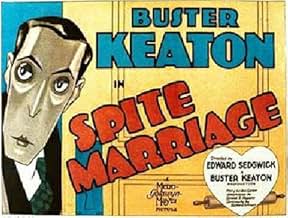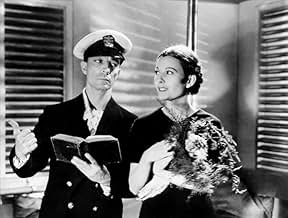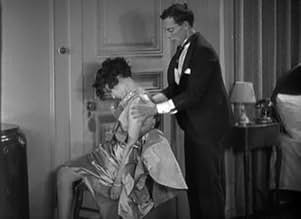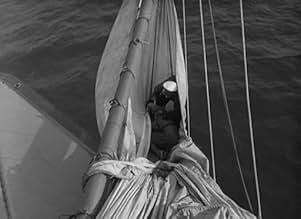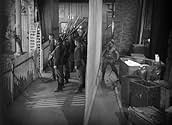Ein unscheinbarer, aber gutmütiger Mann erhält die Chance, eine berühmte Schauspielerin zu heiraten, deren hoffnungsloser Fan er ist. Ihm ist jedoch nicht klar, dass er nur dazu benutzt wird... Alles lesenEin unscheinbarer, aber gutmütiger Mann erhält die Chance, eine berühmte Schauspielerin zu heiraten, deren hoffnungsloser Fan er ist. Ihm ist jedoch nicht klar, dass er nur dazu benutzt wird, den Verflossenen der Schauspielerin eifersüchtig zu machen.Ein unscheinbarer, aber gutmütiger Mann erhält die Chance, eine berühmte Schauspielerin zu heiraten, deren hoffnungsloser Fan er ist. Ihm ist jedoch nicht klar, dass er nur dazu benutzt wird, den Verflossenen der Schauspielerin eifersüchtig zu machen.
- Regie
- Drehbuch
- Hauptbesetzung
- Giovanni Scarzi
- (as John Byron)
- Rumrunner
- (Nicht genannt)
- The Bellboy
- (Nicht genannt)
- Man in Ship's Engine Room
- (Nicht genannt)
- Tugboat Captain
- (Nicht genannt)
- Man in Audience Next to Elmer
- (Nicht genannt)
- Actor as 'Union Officer'
- (Nicht genannt)
- Stage Manager
- (Nicht genannt)
- Tough Sailor
- (Nicht genannt)
Empfohlene Bewertungen
With all of that said, 'Spite Marriage' has a 34-year-old Buster Keaton still in his prime, and some pretty clever scenes. He gets enlisted into a stage play in the first part, and after botching up his make-up while another actor puts his on professionally, proceeds to foul up the production in various funny ways. As he tries to elude those chasing him afterwards, he does a rapid change into a top hat and tails that is both entertaining and shows off his muscular body. Later in the film, he does some impressive stuntwork on a yacht, at one point getting thrown off, and then as the yacht goes by quickly, catches a small boat trailing behind and hauls himself into it. Throughout the movie, he's lovable and a joy to watch. This was Keaton's last silent picture, and as the 1930's would not be kind to him, it marks a transition for him. If you can avoid comparing it to his masterpieces (which I know is tough!), you'll probably find it's well worth watching.
The premise of the "Spite Marriage" is rather flimsy at best, and in other hands it probably would not have been even this good. It actually starts out pretty well, as the first part moves at a good pace, and includes a very good sequence with Buster's hapless character trying to take part in a play. It begins to peter out in the middle, though, as the premise begins to wear thin. For some reason, the bedroom sequence from this portion seems to be the best-remembered portion of the movie, but it really isn't one of the better parts of the film at all. But things pick up again in the last part, when the story takes a couple of unexpected turns, and the comedy also improves.
To be sure, it is a shame that Keaton was forced into the studio mold in pictures like this. It worked for many, but not for a unique talent like Buster. Still, at least this time the result is a generally entertaining movie with more than enough laughs to make it worth watching for anyone who enjoys silent comedies.
Fortunately, while this IS an MGM-produced film, it is much better than most. The difference between the quality of this film and his next (FREE AND EASY) is dramatic--mostly because by the time FREE AND EASY came along, Keaton was only an actor and had no say in the creative process. This was insane, but the butt-heads at MGM wanted it this way. This was akin to hiring Picasso but only letting him do clown paintings!! SPITE MARRIAGE consists of three distinct sections and each are quite different in quality. The first consists of Keaton slavishly longing for a stage actress who has no idea that he even exists. While parts of this are very funny, the film oddly relies way too much on pathos compared to Keaton's other works--this was more Chaplin's style but now MGM was pushing Keaton this direction. I'd say this part of the movie would merit a score of 7. The second consists of when Keaton dates and then marries this selfish actress. The film grinds to a comedic halt and the highlight, so to speak, is when he spends what seems like an eternity to stick his drunk wife in bed. This was tedious and terribly unfunny--earning a score of 3. The final segment of the film was when Keaton oddly went out to sea. How this all was arranged was very silly and contrived, but once he was there the film finally showed the earlier Keaton magic--with amazing stunts like you'd expect in a Keaton film. How much of this was actually Keaton is debatable, as MGM was worried he'd get killed doing these dangerous stunts--even though Keaton was a master at this (as seen in STEAMBOAT BILL JUNIOR). Because the film's timing and laughs were impeccable, I'd give the final portion a score of 10--thus ending the movie on a very high note. Overall, averaging it all together, the film earns a 7.
Had Keaton continued to make movies of the quality of SPITE MARRIAGE, his career at MGM would have no-doubt flourished for many years, as the film comes very close to earning a score of 8 and is very watchable.
He has abruptly grown into those strong bones at last. The alteration is not unbecoming, but it's undoubtedly somewhat marked.
As to why, precisely, I found myself speculating so extensively during the first half of the film on the changes in Keaton's personal appearance... I'm afraid it was because I didn't find it very funny.
The opening scenes have their moments, certainly. Dorothy Sebastian gets good material and can act, and so can Keaton -- when he's allowed. But too much of the humour I found simply to be farcical clowning: in an earlier film, the routine with the hats, for example, might have lasted a second or so for a throwaway laugh, but here it's milked far beyond what it can bear, and much of the other business I felt to be equally forced. There are moments that fly past with Keaton's old lightness of touch, such as the revelation of the true source of his elegant clothing, but there seems to be a general feeling that if a joke is worth doing once, it is worth labouring to death.
The sequence in which 'Elmer' disrupts the performance of the Civil War melodrama was, for me, more a matter of cringing than laughter; it's only fair to say that these sentiments were very definitely not shared by those in the seats nearby, and it may well just be a case of my aversion to the destructive nature of slapstick humour. But what I love about Keaton isn't his ability to fall over things and knock things down -- any comic worth his salt can do that -- it's the ingenuity and resourceful illogic of his invention at its best, and there's precious little of that on show here.
Fortunately, matters improve thereafter, as he is allowed a little more resource. Miss Sebastian shines during the restaurant scene, with Buster as second fiddle, and he is able to advance his relationship with his 'wife' during this section of the film into something a little more complex than fatuous knock-kneed idolatry. I have to confess that I didn't find the scene where he tries endlessly to put her to bed to be as classic as it's apparently held, although I did appreciate his typically Keatonesque solution to the chair problem, but the film definitely picks up from around this point.
The real enjoyment for me, however, only started when Elmer and the girl are left alone on the yacht together; it's almost as if a script that has been written to date by somebody else is taken over by an inspiration that's characteristically Keaton's, as both he and his character rise to the occasion. It occurs to me in passing to wonder if isolation of the filming crew aboard the yacht could possibly have helped foil studio interference..? But maybe it's simply that this is the Keaton we're used to, coming up with wonderfully complex schemes, disabling an entire crew of villains one by one or launching himself intrepidly into the unknown mysteries of the rigging. I was struck by the difference in tone between the sympathetic comedy of this section, where he tries to reduce sail with the help of the girl and the handicap of their joint ignorance, and the earlier, clumsy, 'varnishing' sequence, in which he is purely inept and we are expected to find it funny.
If the 'adrift alone' theme echoes "The Navigator", then the final knock-down fight inevitably recalls "Battling Butler"; as in that film, Keaton produces not only an athletic but a well-acted confrontation, as Elmer faces up to an opponent tall enough and strong enough to hold him ineffectual at arm's-length... armed only with bantam courage, and the luck and resolve that enable him to survive and keep coming back for more even as he visibly tires. And the payoff in the final line of this scene repaid, for me, all the clumsy physical clowning of the stage scenes earlier! (I must add that as a satire on overwrought drama, I actually find the depiction itself of the play "Carolina" quite funny; it's Buster's distinctly unsubtle involvement that grates on me so.)
At the start of "Spite Marriage", I'd have been hard put to rate it above a wavering 5 or 6, with the low comedy of scenes such as the riding encounter definitely toward the low end of that scale. I was pleasantly surprised to find it veering upwards as it went on, into the territory of 7 or above, and the ending I'd generally rate at an 8. (The return of the hat gag, I have to say, was not to my taste!) However, I cannot in all conscience give the film as a whole a ranking above about seven on my personal scale: worth watching, worth recommending to others, but not really worth going through discomfort or inconvenience to see.
Edit: re-watching this film with the original soundtrack (the love theme, "I'm Afraid of You", is certainly appropriate!), I'm impressed above all by Dorothy Sebastian's performance; now that I've seen his later work, Keaton's performance and material here actually reminds me more of his sound-era pictures. You may not be able to hear his voice, but you can certainly see a lot of the same mannerisms appearing...
Wusstest du schon
- WissenswertesBuster Keaton wanted this film to be a full talkie, but MGM released it with only a musical score and sound effects. One thing that prevented this picture from being a full talkie was that MGM was late to the sound game and had only one full set of recording equipment at the time. Its Loew's Theater chain also was not yet fully equipped to show sound pictures. Plus, MGM's head of production reasoned Keaton's films were made with a lot of time-consuming improvisations and didn't think the added expense of using valuable, scarce sound equipment was worth it.
- PatzerIn the dressing-room, while attempting to trim the hair for his false beard, Elmer accidentally severs the left-hand shoulder strap of his tank-top undershirt and has no time to repair it. When he hurriedly changes back into his smart clothes after the performance, both straps are still whole.
- Zitate
Trilby Drew: What's that blonde hanging around you for?
Lionel Benmore: Can I help it if I'm good-looking?
- Crazy CreditsRather than appear at the beginning, the MGM roaring lion opening appears after the conclusion of the film, but just before "The End" title, which immediately follows it.
- VerbindungenFeatured in Arena: Cinema: Christmas Special (1976)
- SoundtracksI'd Rather Be Blue Over You
(uncredited)
Music by Fred Fisher
Lyrics by Billy Rose
Played as background music at the cafe
Top-Auswahl
- How long is Spite Marriage?Powered by Alexa
Details
- Erscheinungsdatum
- Herkunftsland
- Sprachen
- Auch bekannt als
- Trotzheirat
- Drehorte
- Hotel Carmel - 201 Broadway St, Santa Monica, Kalifornien, USA(Lionel confronts Buster outside this hotel on the 2nd Street side - still in business in 2022)
- Produktionsfirma
- Weitere beteiligte Unternehmen bei IMDbPro anzeigen
- Laufzeit1 Stunde 16 Minuten
- Farbe
- Seitenverhältnis
- 1.33 : 1
Zu dieser Seite beitragen


